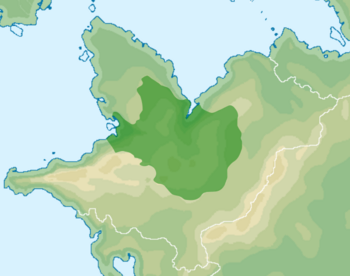Chaan Dynasty
Chaan Chaan Nimja | |||||||||
|---|---|---|---|---|---|---|---|---|---|
| 202 BC–9 AD; 25 AD–220 AD | |||||||||
 A map of the Chaan Mutul at its greatest extend | |||||||||
| Capital | Yux | ||||||||
| Common languages | Classical Mutulese | ||||||||
| Religion | White Path | ||||||||
| Government | Monarchy | ||||||||
| K'uhul Ajaw | |||||||||
| Historical era | classical | ||||||||
| 340 BCE | |||||||||
| 300 BC | |||||||||
| 315 BC–300 BC | |||||||||
| 250 AD | |||||||||
| |||||||||
The Chaan dynasty (Mutli : Chan Nimja) was the second divine dynasty of the Mutul, preceded by the 50 years long Nakabe Revolt, and then followed by the War of the Princes. It lasted for over 470 years, from 320 BC to 250 AD, and is considered a golden age of the Mutulese history.
The period saw a number of limited institutional innovations. The Chaan government centralized the prerogatives traditionally reserved to rulers, such as the control of the roads and of waterways, with strengthened control over marketplaces, banks, and various lenders, while the aristocracy continued to be responsible of the transport of goods and products from markets to markets, from the producer to the consumer. Science and technology during the Chaan period saw significant advances including the process of papermaking and the use of negative numbers in mathematics.